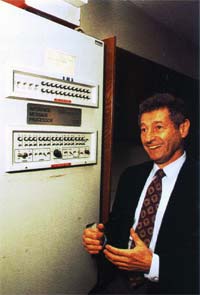ARPANET adopted TCP/IP on January 1, 1983, and from there researchers began to assemble the “network of networks” that became the modern Internet. The online world then took on a more recognizable form in 1990, when computer scientist Tim Berners-Lee invented the World Wide Web.
In general, an internet was any network using TCP/IP. It was around the time when ARPANET was interlinked with NSFNET in the late 1980s, that the term was used as the name of the network, Internet, being the large and global TCP/IP network.
 On August 29, 1969, the first network switchand the first piece of network equipment called "IMP" (Interface Message Processor) is sent to UCLA.
On August 29, 1969, the first network switchand the first piece of network equipment called "IMP" (Interface Message Processor) is sent to UCLA.

In general, an internet was any network using TCP/IP. It was around the time when ARPANET was interlinked with NSFNET in the late 1980s, that the term was used as the name of the network, Internet, being the large and global TCP/IP network.
 On August 29, 1969, the first network switchand the first piece of network equipment called "IMP" (Interface Message Processor) is sent to UCLA.
On August 29, 1969, the first network switchand the first piece of network equipment called "IMP" (Interface Message Processor) is sent to UCLA.
On September 2, 1969, the first data moves from the UCLA host to the switch. The picture to the right is Leonard Kleinrock next to the IMP.
The first message and network crash
On Friday October 29, 1969 at 10:30 p.m., the first Internet message was sent from computer science Professor Leonard KleinRock's laboratory at UCLA, after the second piece of network equipment was installed at SRI. The connection not only enabled the first transmission to be made, but is also considered the first Internet backbone.
The first message to be distributed was "LO", which was an attempt at "LOGIN" by Charley S. Kline to log into the SRI computer from UCLA. However, the message was unable to be completed because the SRI system crashed. Shortly after the crash, the issue was resolved, and he was able to log into the computer.

E-mail is developed
Ray Tomlinson sends the first network e-mail in 1971. It's the first messaging system to send messages across a network to other users.

